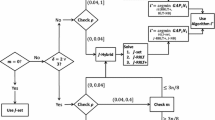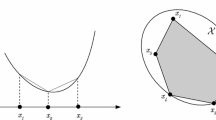Abstract
The best formulations for some combinatorial optimization problems are integer linear programming models with an exponential number of rows and/or columns, which are solved incrementally by generating missing rows and columns only when needed. As an alternative to row generation, some exponential formulations can be rewritten in a compact extended form, which have only a polynomial number of constraints and a polynomial, although larger, number of variables. As an alternative to column generation, there are compact extended formulations for the dual problems, which lead to compact equivalent primal formulations, again with only a polynomial number of constraints and variables. In this this paper we introduce a tool to derive compact extended formulations and survey many combinatorial optimization problems for which it can be applied. The tool is based on the possibility of formulating the separation procedure by an LP model. It can be seen as one further method to generate compact extended formulations besides other tools of geometric and combinatorial nature present in the literature.



Similar content being viewed by others
References
Appelgren, L. (1969). A column generation algorithm for a ship scheduling problem. Transportation Science, 3, 53–68.
Barahona, F. (1993). On cuts and matchings in planar graphs. Mathematical Programming, 60, 53–68.
Barahona, F., Jünger, M., & Reinelt, G. (1989). Experiments in quadratic 0–1 programming. Mathematical Programming, 44, 127–137.
Barnhart, C., Johnson, E. L., Nemhauser, G. L., Savelsbergh, M. W. P., & Vance, P. H. (1998). Branch-and-price: Column generation for solving huge integer programs. Operations Research, 46(3), 316–329.
Berman, H. M., Westbrook, J., Feng, Z., Gilliland, G., Bhat, T. N., Weissig, H., et al. (2000). The protein data bank. Nucleic Acids Research, 28, 235–242.
Bertsimas, D., & Sim, M. (2003). Robust discrete optimization and network flows. Mathematical Programming, 98, 49–71.
Bertsimas, D., & Sim, M. (2004). The price of robustness. Operations Research, 52, 35–53.
Caprara, A. (1999). Sorting permutations by reversals and Eulerian cycle decompositions. SIAM Journal on Discrete Mathematics, 12, 91–110.
Caprara, A., Carr, R. D., Lancia, G., Walenz, B., & Istrail, S. (2004). 1001 optimal PDB structure alignments: Integer programming methods for finding the maximum contact map overlap. Journal of Computational Biology, 11, 27–52.
Caprara, A., Lancia, G., & Ng, S. K. (2001). Sorting permutations by reversal through branch-and-price. Informs Journal on Computing, 13, 224–244.
Caprara, A., Panconesi, A., & Rizzi, R. (2003). Packing cycles in undirected graphs. Journal of Algorithms, 48, 239–256.
Carr, R. D., & Lancia, G. (2002). Compact vs. exponential-size LP relaxations. Operations Research Letters, 30, 57–65.
Carr, R. D., & Lancia, G. (2004). Compact optimization can outperform separation: A case study in structural proteomics. 4OR, 2, 221–233.
Chvátal, V. (1975). On certain polytopes associated with graphs. Journal of Combinatorial Theory Series B, 18, 138–154.
Conforti, M., Cornuéjols, G., & Zambelli, G. (2010). Extended formulations in combinatorial optimization. 4OR, 8, 1–48.
Cook, W. J., Cunningham, W. H., Pulleyblank, W. R., & Schrijver, A. (1998). Combinatorial optimization. New York: Wiley.
Dantzig, G. B., Fulkerson, R., & Johnson, S. M. (1954). Solution of a large-scale traveling salesman problem. Operations Research, 2, 393–410.
de Carvalho, J. M. V. (1999). Exact solutions of bin-packing problems using column generation and branch-and-bound. Annals of Operations Research, 86, 629–665.
de Carvalho, J. M. V. (2002). LP models for bin packing and cutting stock problems. European Journal of Operational Research, 141, 253–273.
De Simone, C., & Rinaldi, G. (1994). A cutting plane algorithm for the max-cut problem. Optimization Methods and Software, 3, 195–214.
Fiorini, S., Massar, S., Pokutta, S., Raj Tiwary, H., & de Wolf, R. (2012). Linear vs. semidefinite extended formulations: Exponential separation and strong lower bounds. In 44th ACM symposium on theory of computing (STOC 2012), New York, NY, USA, 19–22 May 2012.
Fischetti, M., Lancia, G., & Serafini, P. (2002). Exact algorithms for minimum routing cost trees. Networks, 39, 1–13.
Fischetti, M., & Monaci, M. (2012). Cutting plane versus compact formulations for uncertain (integer) linear programs. Mathematical Programming Computation, 4, 239–273.
Gerards, A. M. H., & Schrijver, A. (1986). Matrices with the Edmonds–Johnson property. Combinatorica, 6, 365–379.
Gilmore, P. C., & Gomory, R. E. (1961). A linear programming approach to the cutting stock problem. Operations Research, 9, 849–859.
Gilmore, P. C., & Gomory, R. E. (1963). A linear programming approach to the cutting stock problem—II. Operations Research, 11, 863–888.
Goldman, D., Istrail, S., & Papadimitriou, C. (1999). Algorithmic aspects of protein structure similarity. In Proceedings of the 40th annual IEEE symposium on foundations of computer science (pp. 512–522).
Grötschel, M., Jünger, M., & Reinelt, G. (1987). Calculating exact ground states of spin glasses: A polyhedral approach. In: J.L. van Hemmen & I. Morgenstern (Eds.), Heidelberg colloquium on glassy dynamics (pp. 325–353). Berlin: Springer.
Grötschel, M., & Holland, O. (1991). Solution of large-scale travelling salesman problems. Mathematical Programming, 51(2), 141–202.
Grötschel, M., Lovász, L., & Schrijver, A. (1981). The ellipsoid method and its consequences in combinatorial optimization. Combinatorica, 1, 169–197.
Grötschel, M., Lovász, L., & Schrijver, A. (1988). Geometric algorithms and combinatorial optimization. Berlin: Springer.
Hu, T. C. (1974). Optimum communication spanning trees. SIAM Journal on Computing, 3, 188–195.
Kaibel, V. (2011). Extended formulations in combinatorial optimization. arXiv preprint arXiv:1104.1023.
Kaibel, V., & Pashkovich, K. (2011). Constructing extended formulations from reflection relations. In: O. Günlük & G. Woeginger (Eds.), Integer programming and combinatorial optimization XV, lecture notes in computer science 6655 (pp. 287–300). Springer.
Lancia, G., Carr, R. D., Walenz, B., & Istrail, S. (2001). 101 optimal PDB structure alignments: a branch-and-cut algorithm for the maximum contact map overlap problem. In: Proceedings of 5th ACM international conference on computational molecular biology (RECOMB) (pp. 193–202).
Lancia, G., Rinaldi, F., & Serafini, P. (2011). A time-indexed LP-based approach for min-sum job-shop problems. Annals of Operations Research, 86, 175–198.
Lancia, G., & Serafini, P. (2011). An effective compact formulation of the max cut problem on sparse graphs. Electronic Notes in Discrete Mathematics, 37, 111–116.
Lancia, G., & Serafini, P. (2014). Deriving compact extended formulations via LP-based separation techniques. 4OR-A Quarterly Journal of Operations Research, 12, 201–234.
Lenhof, H. P., Reinert, K., & Vingron, M. (1998). A polyhedral approach to RNA sequence structure alignment. Journal of Computational Biology, 5, 517–530.
Martin, K. (1991). Using separation algorithms to generate mixed integer model reformulations. Operations Research Letters, 10, 119–128.
Monaci, M., & Pferschy, U. (2011). On the robust knapsack problem. SIAM Journal on Optimization, 23, 1956–1982.
Monaci, M., Pferschy, U., & Serafini, P. (2013). Exact solution of the robust knapsack problem. Computers & Operations Research, 40, 2625–2631.
Newman, A. (2008). Max cut. In M.-Y. Kao (Ed.), Encyclopedia of algorithms (pp. 1–99). New York: Springer.
Padberg, M., & Rinaldi, G. (1991). A branch-and-cut algorithm for the resolution of large-scale symmetric traveling salesman problems. SIAM Review, 33(1), 60–100.
Stoer, M., & Wagner, F. (1994). A simple mincut algorithm. In Proceedings of ESA 94, lecture notes in computer science 855 (pp. 141–147). Berlin: Springer.
Villeneuve, D., Desrosiers, J., Lübbecke, M. E., & Soumis, F. (2005). On compact formulations for integer programs solved by column generation. Annals of Operations Research, 139, 375–388.
Wu, B. Y., Lancia, G., Bafna, V., Chao, K. M., Ravi, R., & Tang, C. Y. (1999). A polynomial-time approximation scheme for minimum routing cost spanning trees. SIAM Journal on Computing, 29, 761–778.
Yannakakis, M. (1991). Expressing combinatorial optimization problems by linear programs. Journal of Computer and System Sciences, 43, 441–466.
Author information
Authors and Affiliations
Corresponding author
Additional information
This is an updated version of the paper that appeared in 4OR, 12(3), 201–234, (2014).
Rights and permissions
About this article
Cite this article
Lancia, G., Serafini, P. Deriving compact extended formulations via LP-based separation techniques. Ann Oper Res 240, 321–350 (2016). https://doi.org/10.1007/s10479-015-2012-4
Published:
Issue Date:
DOI: https://doi.org/10.1007/s10479-015-2012-4




